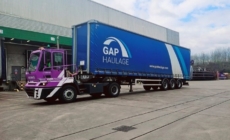-
Nutrivend selects Forterro’s Orderwise to support online expansion and streamline operations - April 11, 2025
-
ARROWXL LAUNCHES AMBITIOUS ZERO WASTE ROADMAP - April 8, 2025
-
THE BCMPA’S NEW CAMPAIGN DRIVES OUTSOURCING SUCCESS IN Q1 - April 7, 2025
-
BLACKOUT TECHNOLOGIES TARGETS TELEMATICS-INTEGRATED MOBILE DEVICE BLOCKING TO COMBAT SMARTPHONE DISTRACTION - April 1, 2025
-
OpenADR Alliance announces first OpenADR 3.0 certified products with EVoke Systems, E.ON Energy and Universal Devices - March 25, 2025
-
Growing fulfilment and contract packer appoints new Managing Director - March 25, 2025
-
When is it time to invest in a WMS? Understanding the key trigger points - March 25, 2025
-
eCapital helps Vantage Recruitment on its journey to financial success - March 24, 2025
-
Hugo Beck Celebrates 70 Years of Packaging Innovation with Open House Events - March 20, 2025
-
PROLOG FULFILMENT SUPPORTS LUNA DAILY’S COMMITMENT TO BETTER BODY CARE FOR ALL WOMEN - March 19, 2025
Maintaining a library of information pertaining to the record of a part as it moves through a supply chain can be a significant challenge, even for smaller companies with relatively simple operations. But a suitable ERP system can provide a logical and appropriate organising framework.
Every part number has to have a backstory. There is an ever-growing list of attributes, histories and events, not only technical but also legal, fiscal, and increasingly social and environmental, that customers or regulators may require being available, auditable and certifiable. They may apply at batch, lot or individual item level; they may require to be referenced many months or years after manufacture or sale; and they may include attributes that have been inherited from many tiers back up the supply chain.
Some requirements are obvious and familiar: for example Certificates of Compliance to Standards including ISO, EN, CE, DIN, BS, ASME, IEEE and so on. These may be applicable to all products of the same design, but if for example a testing regime is involved then this needs to be linked to individual items.
Chemical composition of goods and materials is a growing area for certification. In Europe (and still including the UK) there are the RoHS (Restriction of Hazardous Substances) and REACH (Regulation, Evaluation, Authorisation and restriction of Chemicals) Directives. Manufacturers, or their customers, exposed to US markets also need to consider ‘Proposition 65’. This is a Californian law, but since citizens of that State can buy, and sue, across the US its impact is countrywide. Proposition 65 covers some 900 (and counting) supposedly hazardous chemicals and substances whose presence in a product has to be declared, and this includes quite a few substances that aren’t regarded as risky on this side of the pond. Documenting compliance with all these requires a reliable flow of information from the upstream supply chain.
Other manufacturing and process factors that may need to be auditable or certifiable might include the maintenance of particular temperature or environmental conditions; ‘clean room’ certification; or proof that operatives such as welders have current certification. For some goods, conditions of transport, inbound or outbound, may also be relevant.
Food manufacturing, cosmetics, pharmaceuticals have their own thickets of regulation around what ingredients and processes are allowed, from ingredients to packaging materials. Traceability of the contents of individual batches is often mandatory but can be difficult as inputs are themselves often a mix of substances from different sources, and those sources may themselves change, perhaps seasonally or in response to market forces.
There is also a growing number of fiscal, commercial, social and environmental needs for information tagged to the individual batch or item.
Customers are demanding certification that supplies are free of ‘conflict minerals’. Pressure for similar certification around labour rights and modern slavery is growing in, for example, the fashion industry. Both of these need auditable data to follow the goods from mine or mill right through an often torturous supply chain.
‘Country of Origin’ certification is a big issue, especially post-Brexit, and is not always straightforward – where are the components you buy in from a multinational made. Fiscal matters may need to be traced to individual items or batches. The payment, and reclamation, of tariffs is one issue. This is quite topical post-Brexit and if the UK creates a system of ‘freeports’. Other duties may need an audit trail back to the product.
But the biggest audit requirement will be for carbon accounting. Consumers, governments and corporations are beginning to demand auditable evidence of the carbon footprints of the goods they purchase. This will have to extend far up the supply chain and may become quite complex, even for a firm’s internal operations: initially, carbon may be treated as an overhead and allocated across the product range pro rata, but the requirement will surely move quickly to associating greater or fewer emissions to particular products lines, which then requires values for each item on the Bill of Materials, and each operation.
Clearly, compliance can’t be demonstrated easily with reams of paper certificates. Digitising this raft of documentation is an obvious first step. But there also needs to be some organisational structure that can associate the relevant information permanently with lots, batches and individual items as they pass through manufacturing and on to the customer or consumer.
The obvious architecture for most manufacturers would be an ERP system. This, after all, exists primarily to create the associations between inputs and the manufactured output. A part number, ‘travelling’ on the Bill of Materials through the manufacturing process, can drag all those associations with it.
Simple. But beware: not all ERP systems are created equal in this regard, and some, even quite high end, systems have significant deficiencies.
Firstly, not all systems readily support a multi-level BOM, especially one that extends outwith the manufacturer’s ‘four walls’. This is essential as it will require drilling into the upstream supply tiers to establish the true history and provenance of items.
A second consideration is that not all ERP systems are adept at splitting inputs. You may buy a part as a SKU of 12, using two in each product. That part number thus needs to be allocated to six different product serials. The problem is more acute when the input is not in discrete units – a food manufacturer, for example, may use the same parcel of a particular spice, not only in different batches, but perhaps in different products.
Also it may well be that distributed ledger technology (blockchain) becomes the preferred methodology for verifying compliance, and an ERP architecture needs to at least have this in mind.
Fortunately, ERP system from MRPeasy, despite being designed to be simple, accessible and affordable, do indeed offer these and other features to support compliance requirements that may seem arcane, but are rapidly becoming all pervasive. Firms that can’t readily offer auditable evidence of compliance with customer and regulatory requirements will rapidly find themselves squeezed out of contention; on the other hand, with a bit of forethought
and a robust organisational framework the may find they can satisfy the requirements rather more easily than the larger players.
For more information, visit www.mrpeasy.com
Author: Karl H. Lauri, managing team member at MRPeasy.com. MRPeasy.com is a cloud-based, affordable and user-friendly, ERP/MRP software for small manufacturers and distributors (10-200 employees).

































